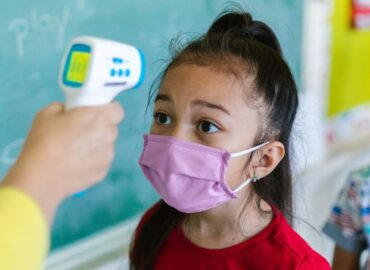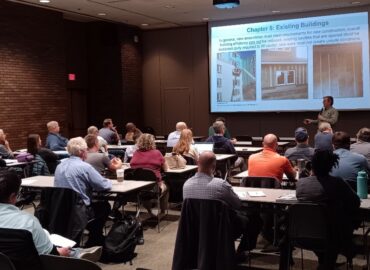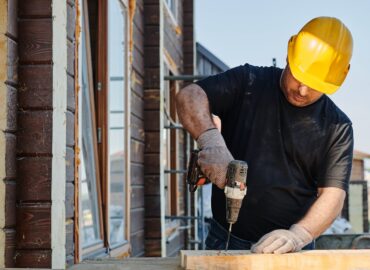With winter approaching and COVID-19 cases increasing rapidly, it’s time to reevaluate building safety precautions. Investing in solutions to reduce virus transmission risk can protect building occupants long after the pandemic is over. This checklist provides guidance for reducing virus transmission and reopening after a long shutdown.
Do you regularly monitor the CO2 concentration in various zones in your facility, as well as the humidity and temperature? CO2 sensors are the most common way to determine if enough outside air is being supplied. Depending on your situation, a handheld CO2 sensor can be used with a schedule of spot checks, or for long-term applications, wall mounted sensors can be installed for continuous monitoring. If you have a building automation system (BAS) you may already have these sensors. If you do not have them, consult with an engineer on options for monitoring technologies and optimal locations and times to take readings.
Is the ventilation system delivering enough outside air for the amount of users that are in your building? Use CO2 monitors to determine whether your facility has achieved the target of 800 ppm or less of CO2 concentration when fully occupied (40 cfm per person fresh air). Many existing systems are set to maintain 1100-1200 ppm of CO2 or do not control ventilation at all.
Have you increased the amount of outside air circulated in your facility? If you have demand control ventilation (DCV), adjust it so that it is set to 800 ppm or lower. If there is no DCV setpoint control, or no DCV installed, adjust outdoor air dampers to maintain 800 ppm CO2 when spaces are fully occupied. If there is no mechanical ventilation, open the windows if temperatures allow. Consult with a professional engineer on options for system modifications.
Is your filter MERV 13 or higher, or at least MERV 11? Check to determine whether your air handling unit can support a higher efficiency filter. If your system does not allow a filter upgrade, consult with a professional engineer on options for system modifications.
Are the filters cleaned and/or replaced on a regular basis? Dirty filters reduce HVAC efficiency and, in the long term, can reduce equipment life. Remember to seal the edges of the filters to limit bypass. Also, to avoid spreading the virus, it is important to wear gloves and masks when changing filters, and to place used filters in sealed bags.
Has your HVAC system and equipment been regularly inspected and maintained? Make sure all outdoor air intakes and building exhaust fans are working properly. Also, remember to schedule annual tune-ups for all heating and cooling equipment.
Have you added ultraviolet germicidal irradiation to the recirculation air stream (0.02 Wuv per cfm of building airflow)? Lamps providing UV-C wavelength light have germicidal properties, destroying proteins and DNA in microbes that inactivate them. While these systems consume energy, they provide benefits to the system beyond outdoor air flushing. They may provide some energy savings if used in the air handler to irradiate the cooling coils as well as the airstream, preventing build-up of biofilms.
Do you restrict the amount of people allowed in a room at a time so that everyone can stay at least 6 feet apart? Arrange tables and chairs so that occupants are at least 6 feet apart. This equates to approximately 30 square feet per person.
Are frequently touched surfaces cleaned and disinfected at least once a day? Make tissues, no touch trash cans, and touchless hand sanitizer stations available. Use posters to promote hygiene.
Do you have signs or a building policy on mask wearing? Place signs in common areas and high-occupancy areas reminding occupants to wear masks to limit the spread of COVID-19.
If you are reopening your facility after an extended period of closure, have you checked for indoor air quality problems such as mold and moisture? If the HVAC system was off during the closure, mold or moisture may be an indication that there are envelope issues that need to be addressed. If the HVAC system was running during the closure, mold or moisture may be an indication that ventilation is poor or humidity controls are inadequate. If dampness/mold is detected, address the source of water entry, then conduct clean-up and remediation.
Is your water heater properly maintained? Ensure water heater settings that maintain at least 120°F in the tank and distribution system to prevent potential legionella outbreaks. For buildings that have been unoccupied for extended periods, flush water through all fixtures to ensure chlorination has reached all areas of the water piping system to prevent microbial outbreaks.





